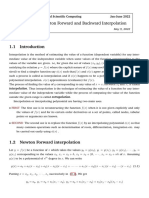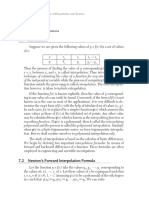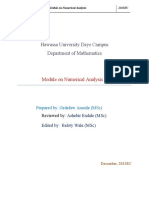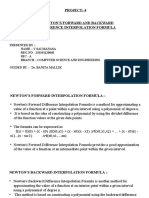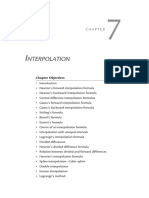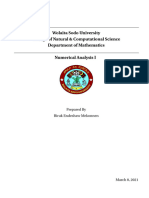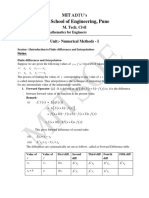0 ratings0% found this document useful (0 votes)
87 views66 pagesModule 5 Numerical Methods 1
Uploaded by
studywithmecattyCopyright
© © All Rights Reserved
We take content rights seriously. If you suspect this is your content, claim it here.
Available Formats
Download as PDF or read online on Scribd
0 ratings0% found this document useful (0 votes)
87 views66 pagesModule 5 Numerical Methods 1
Uploaded by
studywithmecattyCopyright
© © All Rights Reserved
We take content rights seriously. If you suspect this is your content, claim it here.
Available Formats
Download as PDF or read online on Scribd
You are on page 1/ 66
MODULE - V 265
\DVANCED CALCULUS :
ul Mathematlics I! Engitneerttiyg Mathematlles I Englincerling Mathematil
tllcs II Engllneer & ithematllcs 1] EnglIneerlIng
tllcs II EnglIncerttMe@lathematiles II EnglIncerling Mathernatlk
matllcs I EnglIneerll thematlles ILEr hemat]l
RICAL METHODS |
IncerlIng Mathe thematlics [I EnglIneerlIng Mathemat!Ic
IneerlIng Mathematics II EnglineerlIng Mathematlles
EnglIneerlIng Math« ring Mathematllcs I
ering Mathema
sneering Mathemaitlles ll Englineerling Mathematllcs
tllcs I EnglineerlIng Mathematiles Il Engllneerling Mathematl
tllcs II EnglIncerlIng MathematlIcs Il EnglIneerling Mathemat!
We come across with situations having a data comprising a set of
discrete values of the dependent variable corresponding to various values
of the independent variable.
In this module, Numerical Methods are discussed for the following
situations.
Estimating to the desired degree of accuracy the value of the dependent
variable corresponding to a value of the independent variable and also
knowing the form of function satisfying all the conditions on hand,
referred to as Interpolation.
Solution of polynomial and transcendental equations, by locating
an approximate real root or an interval containing real root &
subsequently improving the accuracy of the root.
Evaluation of a definite integral without the actual integration of the
function, by using some discrete values of the function, referred to as
Numerical Integration.
266 ADVANCED CALCULUS & NUMERICAL METHODS - 18 MAT 21
MODULE - V 267
NUMERICAL METHODS
5.1] Finite differences
Consider a function y = f(x). Let x, ,x, =x, +h x, =x,+h,-~,
x, = X,, +h bea set of points at a common interval h. Let the corresponding,
values of y= f(x) be ¥ =f(%))¥, =f (x) ¥, =f) ¥, =f, )-
The value of the independent variable x is called the argument and the
corresponding functional value is known as entry. We define forward and
backward differences concerning these values.
Forward differences
The first forward difference of f (x) denoted by Af (x) is defined as follows.
Af (x) = f (x+h)- f(x)
A is called the forward difference operator.
Now, we have for the values x), %,,%,). +. %,:
Af (x,) = F(X) +h)- f(x) or AY,=¥,—Y,
Af (x,) = f(x, +h)~ f(x) Cet as
Af (x,) = f(x, +h)- F(x) or Ay, =y,-y, etc,
AS(H) = FO th) F(% a) or AY =, Ia
The difference of the first forward differences are called second forward
differences. They are as follows.
a’y, =Ay,- Ay,» A°y, = Ay, ~ AY, »
7, = AY, ~ AY MY = AV, ~AYy. 2
Similarly the other higher order differences namely the third, fourth, etc., are
obtained and tabulated. Such a tabular arrangement is called the
forward difference table.
268 ADVANCED CALCULUS & NUMERICAL METHODS - 18 MAT 2,
The first entries in the table namely Ay,, A’ y,, A°y, +++» A" Yp are called
the leading forward differences.
5.12 |Backward differences
The first backward difference of f (x) denoted by V f(x) is defined as follows.
VG) = f ()-f(2-h)
V is called the backward difference operator.
He) ee IG) Ie) le) Ot VY, = Yaa
x,-h=x,, and f(x_,)=y,,
Mh eee VEE IIe oS (4,4 — 8)
ony MIN ont ie te Viet, Vit, ~ Yo
MODULE -V 269
The difference of the first backward differences are known as second backward
differences. They are as follows.
VY, = VI Vn VY = Vo, VY,
Pahoa
vty, = Vy, -Vy,
Similarly the other higher order backward differences namely the third, fourth
etc., are formed and tabulated. Such a tabular arrangement is called the
backward difference table :
The last entries in the table namely vy, ,W? y, Ww? Y,rV"y, are called
the leading backward differences.
ILLUSTRATIVE EXAMPLE
Let us construct a finite difference table for the function f (x) =x° +x +1 where
x takes the values 0, 1, 2, 3, 4, 5, 6 and identify the leading forward and backward
differences.
270 ADVANCED CALCULUS & NUMERICAL METHODS - 18 MAT 21
f(x) =x° +x+1 by data. From this we obtain,
Ff (0) =1,f (1) = 3, (2) = 11, f(3)= 31, f (4) = 69,
f (5) = 131, f (6) = 223.
The finite difference table is as follows.
ird
Difference
Second
Difference
Taking x, = 0, y, =1, the first value in every column are the leading
forward differences. They are as follows :
Ay, =2, A y, =6,A°y, = 6,A*y, = 0 |
Also by taking x, =6, y, =223, the last value in every column are the leading |
backward differences. They are as follows :
Vy,=92, Vey, =30,V°y, =6,V* y, =0
Interpolation
If ¥/¥,/¥2/--Y, be a set of values of an unknown function y = f (2)
corresponding to the values of x: x,,x,,%,,...x,, the process of finding
(estimating) the value of y for any given value of x between x, and x, is
called interpolation. Also the process of finding (estimating) the value of ¥
outside the given range of x is called extrapolation. In general the concept
of interpolation includes extrapolation also.
MODULE - V 271
Hence we can say that interpolation is a technique of estimating the value of
an unknown function for any intermediate value of the independent variable.
For example, if we have the data :
x 0 4 5 8 10 [| 15
f(x) 6 15 v7 29 40 | 87
the process of estimating f(3),f(7),f (125) , (14) etc. is interpolation
and estimating f (-0.5), f (18), f (25) etc. is extrapolation.
We first discuss interpolation for equal intervals which will be followed with
interpolation for unequal intervals.
Interpolation formulae for equal intervals/equidistant arguments
We discuss interpolation formulae for equal intervals based on forward and
backward differences,
These formulae are established by approximating the unknown function to a
polynomial in x whose values coincide with the value of f (x) at the specified
points of 2X) ,8,) Xp... Xp
Forward difference interpolation formula and Backward difference
interpolation formula.
Let Yo » ¥,/¥,7++-Y,, be the values of an unknown function y=f(x)correspond-
ing to equidistant values of *: x, X, =x, +h,x, =x,+2h,...x, =x, +nh.
Then we have the following two interpolation formulae.
5.31
Newton’s forward interpolation formula
The value of y= f(x) at x = x, +rh, thatis ¥, =f (x, +rh) is approximately
given by
v= +7 dy, MN gy . Hear 2Dy, « 4 POP= 1 (r=2) (r=
where r is any real number.
272 ADVANCED CALCULUS & NUMERICAL METHODS - 18 MAT 21
[5.32] Newton's backward interpolation formula
The value of y=f(x)atx=x,+rh, thatis y, = f(x, + rh) is approximately
given by
Heys rH D) yoy . MCP A) (r+ 2dr +M=T) gu
y,=y,trVy, +" aa n
Appropriate interpolation formula
To estimate the value of y at a desired value of x near the beginning of the
table ( first half, x is close to x, ) forward formula is appropriate.
Similarly to estimate the value of y at a desired value fo x near the end of the
table (second half, x is close to x,) backward formula is appropriate.
The polynomial y = f ( x ) satisfying the data can also be found from these
formulae and it is called an interpolating polynomial.
Note : The word appropriate is used in the sense that the computational work will
involve relatively small magnitudes. Either of the formulae can be used for obtaining
the required result.
Working procedure for problems
Step -1: We construct the difference table in accordance with the interpolation
formula.
Step - 2: We compute the value of r where,
x-x
(a) r = > in the case of forward interpolation formula, x, being
the first value of x and h is the step length.
x-x
(b) 7 = >= in the case of backward interpolation formula, x, being
the last value of x and ht is the step length.
Step - 3: The value of r along with the value of the finite differences are
substituted in the interpolation formula which results in the value of y at the
desired value of x.
Note : If no numerical value is substituted for x in then r= r (2%).
The associated y = f ( x ) is called the interpolating polynomial.
MODULE - V 273
WORKED PROBLEMS
[1] Find y (1.4) given that
x [1 [2 |] 3 4 5
y 10 %6 58 | 112 194
@ Here we have to find y at x = 1.4
Since the value x = 1.4 is in the first half of the table near x = 1,
Newton’s forward interpolation formula is appropriate and we shall construct
the forward difference table :
x y ay | wy ay ay
1 |y,=10
16
2 26 16
32 6
3 58 2 0
4 6
4 112 28
82
5 194
We have Newton's forward interpolation formula =
- r(r-1)(r-2
v= yy tr Ay, DD ary, + PEED) 34, on
ae,
where, r = o
h
x = point at which y is required = 1.4
X, = initial point ( first value of x ) = 1
14-1
h = common interval length = 1. Here "= ~~ = 0.4
From the table, Ay, = 16, A*y, = 16, A°y, = 6, A*y, = 0
(0.4)(0-4=1) (16) , (0-4)(0.4 =1
2 6
y(1.4) = f (14) = 10+(0.4)16+
= 10+6.4+(0.4)(-0.6)8+(0.4)(-0.6)(-1.6) = 14.864
Thus, y (1.4) = 14.864
274 ADVANCED CALCULUS & NUMERICAL METHODS - 18 MAT2,
[2] Find u,, from the data :
u, = 225, u, = 238, u, = 320, u, = 340
® The value x = 0.5 is near to x = 0 and hence Newton’s forward interpolation
formula is appropriate.
We shall first construct the forward difference table.
We have Newton's forward interpolation formula :
sq -1)(r-2
yy ray # Mary, 4 ED) ary, as
f (0.5) = 225 +0.5(13) + O9)03-0) (69)
+{05M05-1)(05-2) (_ 131) = 214.689
14.6875
13] The area of a circle (A) corresponding to diameter (D) is given below.
D 80 85 90 95 [_ 100
A 5026 5674 6362 7088 | 7854
Find the area corresponding to diameter 105 using an appropriate interpolation
formula, ,
@ Here we have to find A when D = 105
As this value 105 is near to the end value 100, Newton’s backwar
interpolation formula is appropriate. D and A correspond to x and }
The backward difference table is formed first.
MODULE - V 275
x=D yA [vy [vy
80 5026
648
85 5674
688
90 6362 38
726
95 7088 40
766
x,=100 | y, = 7854
We have Newton’s backward interpolation formula :
e+) yay 4, MFA (r+2) 9
y,=y,trVy,+ , Gl
Trt U(r ars) Vey te
xx, _ 105-100
where, r = ins
e h 5
a -
From the table, Vy, = 766, V7y, = 40, Vy, = 2, V‘y, =4
F (105) = 7854.+1(766)+CX2) 2) (40) + DAC, 2)
+BDACKA 4)
= 7854 + 766 + 40 +2 + 4 = 8666
Thus the area ( A ) corresponding to diameter ( D ) = 105 is [8666
[4] The following table give the values of tan x for 0.10 < x < 0.30. Find tan (0.26)
[x 010 | 0415 | 020 | 025 | 030
| tan x | 0.1003 | vast | 0.2027 | 0.2553 | 0.3093
‘ Here the value x = 0.26 is near the end value 0.30
Hence Newton’s backward interpolation formula is appropriate. The backward
difference table is as follows.
276 ADVANCED CALCULUS & NUMERICAL METHODS - 18 MAT 2
We have Newton's backward interpolation formula :
=y,tr vy, Dry Ze rs) yy,
ELUrt I(r 4 2)(7 +3) ge
a yt
_ 0.26 -0.30
0.05
where, + = =-0.8
From the table
Vy, = 0.0540, v?y = 0.0014, V’y, = 0.0004, V‘y, = 0.0002
f (0.26) = 013093 +(—-0.8)(0.054) (9S) 0.8 21) (0.0014)
(0.8) (-0.8+1)(-0.8+2)
6
(<8) (-0.8+1)(-0.8+2)(-0.8+3) (9 9999)
24
(0.0004)
Ff (0.26) = 0.26602
Thus, tan(0.26) = 0.2660
MODULE - V 277
[5] Extrapolate for 25.4 given the data,
@ We shall first construct the backward difference table
We have Newton’s backward interpolation formula :
¥,=¥, +7 vy, eo Byry +
HAD #2) goy
3! ™
x~%, 25.4 -23
where, r= Se; r = OSS =
24
f (25.4) = 131 +(24)10.75+2IC4*D (95) = 158.84
Thus, f (25.4) = 158.84
[6] Given f ( 40 ) = 184, f ( 50 ) = 204, f ( 60 ) = 226, f ( 70 ) = 250,
Ff ( 80 ) = 276, f ( 90) = 304, find f (38 ) and f ( 85 ) using suitable
interpolation formulae. [une 2018]
Here we shall find f( 38) using Newton's forward interpolation formula
and find f ( 85 ) using Newton's backward interpolation formula. The finite
difference table applicable to both the interpolation formulae is as follows.
r
278 ADVANCED CALCULUS & NUMERICAL METHODS - 18 MAT»,
F(x=y II Difference
184
III Difference |
To find f (38 ) : We have from the table,
x, = 40,y, = 184, Ay, = 20,a7 y, = 2, A°y, =0
We have Newton's forward interpolation formula :
r(r-1) 42
y+ Ay, + 2 AY,
_#-x, 38-40 _ 9
where, f = a 10
f (38) = 184-+(-0.2)(20)+ PE P2=2) (2) = 180.24
Thus, f (38) = 180.24
To find f ( 85} : We have from the table,
x, = 90, y, = 304, Vy, = 28, Vy, = 2, V?y, =0
We have Newton's backward interpolation formula :
ate)
y,=y, tr Vy, + vy, i
x -
5 = 8590
10
where, rf =
MODULE - V 279
1 (85) = 304 +(—0.5)(28)+ <25)C 0541) 9) - 289.75
Thus, Ff (85)
89.75,
[7] Given sin 45° = 0.7071, sin 50° = 0.7660, sin 55° = 0.8192, sin 60° = 0.8660,
find sin 57° using an appropriate interpolation formula. Dune 2018]
@ We have to find the value of f(x) = sin x at x = 57 which is near
the end value x = 60° and hence Newton’s backward interpolation formula
is appropriate. The difference table is as follows.
x fay vy [vy vy
a5 o7071
0.0589
50 0.7660 -0.0057
0.0532 0.0007
55 0.8192 ~0.0064
0.0468
x,=60 | y,= 08660
We have Newton's backward interpolation formula :
Yau ery, Hedy + P(r+I)(r+2) pay
eee Fae
3! ”
2!
where, r = ae prs 57-60 =-0.6
' 5
From the table, Vy, = 0.0468, V?y, = -0.0064, V° y, = -0.0007
f (57) = 0,860 + (-0.6)(0.0468) + PVE 9.) (_ 9.0964)
4 (£.0-6)(-0.6+1)(- 0-642) (_ 9 997) = 0.8387
Thus,
280 ADVANCED CALCULUS & NUMERICAL METHODS - 18 MAT 21
[8] Find the interpolating polynomial f ( x ) satisfying f (0) = 0, f (2) =4,
f(4) = 56, f (6) = 204, f (8) = 496, f ( 10 ) = 980 and hence find f (3),
f(5) and f (7)
@ The interpolating polynomial can be found from either of the two |
interpolation formulae. We shall use Newton's forward interpolation formula, |
The difference table is as follows.
» [roy aw [aw [ov | ov |
20 y=0
Ay, =4
2 4 A? y, = 48
52 Ae y, = 48
4 56 96 At Vy =
148 48
6 204 144 0
292 48
8 496 192
484
10 980
We have Newton's forward interpolation formula :
r(r-1)(r-2)
3!
r(r-1
yy+r ay, +B ary, + My te,
x-x, x-0
* Here, 7 =
where, r =
y= f(x)= ou2 aye 22 Dyas) 2G NGG~4) Je)
eos ae
= 2x +x(x-2)(6)+x(x-2)(x-4)
= x[2+6(x-2)+(x? -2x-4x+8)]
MODULE - V 281
y = f(x) = x[2+6x-124x? 6x48] = x? -2x
Thus the interpolating polynomial is|
Now, by putting x = 3, 5, 7, we obtain
f(3) = 21, f (5) = 115, f(7)= 329}
Note: It may be observed that if we substitute the given values of x namely 0, 2,
4, 6, 8, 10 in the polynomial, the values of f ( x ) coincide with the values given in
the data.
BR From the following table find the number of students who have obtained
(a) less than 45 marks (b) between 40 and 45 marks. [June 2017]
Marks 30-40 40-50 50-60 60-70 70-80
No. of students 31 42 51 35 31
‘ — We shall reconstitute the given table with f ( x ) representing the
number of students less than x marks. That is,
less than 40 marks 31 students,
less than 50 marks 31 + 42 = 73 students,
less than 60 marks 73 + 51 = 124 students,
less than 70 marks 124 + 35 = 159 students,
less than 80 marks 159 + 31 = 190 students,
We have the new table along with the forward differences.
(a) We need to find f (45 ) being the number of students scoring less than 45
marks,
[sea] ay ay ay ay
x= 40 | y,=31
Ay, = 42
50 73 Ary, =9
51 Avy, = -25
60 124 -16 A‘y, = 37
35 12
70 159 -4
31
80 190
282 ADVANCED CALCULUS & NUMERICAL METHODS - 18 MAT 21
We shall find f (45 ) by applying Newton’s forward interpolation formula,
r(r-
2!
- ) r(r-1)(r=2) as
¥,=Yytr Ay, + Ay) + Ay, + 1
xx, 45-40
where, 7 = h a= 10
(45) = 31+(0.5)42+ C2) 05-1) 9)
E 5 = 5 = 5-2)(0.5-3
-, (0:5)(0.5=1)(0.5 2) (95) 4 (0.5)(05 1)(0.5-2)( (37)
6 24
f (45) = 47.86 = 48 _
Thus the number of students obtaining less than 45 marks is 48.
(b) We need to find f (45) - f (40). But f( 40) = 31 by data.
Hence f (45) - f (40) = 48 - 31 = 17
Thus the number of students scoring marks between 40 & 45 is 17.
[10] A survey conducted in a slum locality reveals the following information as
classified below.
Income per day (Rs.)[ Under 10] 10-20 [20-30 | 30-40 | 40-50
No. of persons 20 45 115 ao | 115
|
Estimate the probable number of persons in the income group of 20 to 25.
© The given data is reconstituted with f (x ) representing the number of
persons less than income of Rs. x. That is,
less than Rs. 10 = 20,
less than Rs. 20 = 20 + 45 = 65,
less than Rs. 30 = 65 + 115 = 180,
less than Rs. 40 = 180 + 210 = 390,
less than Rs. 50 = 390 + 115 = 505,
We have to find f( 25) and f ( 20 ) which etimates number of persons having
income less than Rs. 25 and less than Rs. 20 so that their difference, that is
£(25) ~ f (20) will give us the number of persons having income between
Rs. 20 and 25. The new table along with the forward differences is as follows.
MODULE - V 283
x Ay wy Ay aly
x, = 10
45
20 70
15 5
30 95 215
210 -190
40 -%
15
50
We have Newton's forward interpolation formula :
-1 r(r-1)(r-2)
¥, = Uy tr bys UD) dary, ORD ay,
| tr=1)(r=2)(r-3)
a Aty, to,
xox _
where, r=7—%0 , ,~ 2210
n° "> 40
We need to find f ( 25) — f (20).
First we shall find f ( 25 ). We have, r = Ba =15
From the table, Ay, = 45, a Yy = 70, “ae y, = 25, At Yy =-215
Now, f (25) = 20 +1.5( 45)+ F510-5-1) (79)
4 (1.5) (1.5-1)(1.5-2) )- (25)(2.5 -1)4.5-2)(1.5=3)
6
(25 x (-215)
f (25) = 107
Also we have from the table,
Ff (20) =65
Hence, f (25)~f (20) = 107-65 = 42
Thus the number of persons in the income group of Rs. 20 to 25 is 42.
284 ADVANCED CALCULUS & NUMERICAL METHODS - 18 MAT 2
[11] Compute u,,, from the following table by applying Newton's backwang
interpolation formula.
x 10 12 14
0.240 | 0.281 | 0.318
@ — We shall apply Newton's backward interpolation formula and the
difference table is as follows.
x “zy vy vy | vy [ vty
10 0.240
0.041
12 0.281 0.004
0.037 0.001 .
4 0.318 0.003 vty, =0
0.034 vey, =0.001
16 0.352 Vy, =- 0.00; %
Vy, =0.032
x,=18 |y, = 0.384 :
We have Newton's backward interpolation formula :
y ny, er Vy, ogy MINED gry 4.
a. Me 3!
where, r = — i? -H28 =-19
tgs = 0,384 +(-1.9(0.032) +2920?) (-0.002)
+{-49-09)(08) 9.001)
Thus, u,,, = 0.3215
[12] Use Newton's forward interpolation formula to find y,, giver ———
Yay = 512, Yoq = 439, Yyp = 346, Yop = 243.
@ The difference table is as follows.
MODULE - V 285
x | wey Ay ay ay
x= 20 Y= B12
Ay, =-73
30 439 ty, =~ 20
-%8 A’y,= 10
40 346 -10
-103
50. 243,
We have Newton’s forward interpolation formula :
r(r-1 r(r-1)(r-2
y, ayy tr Ay, ED ary, ¢ LE ME=2) gy,
where, 7 = aoe oe 5-20 an
Vyg = ¥ (35) = 512+(1.5)(-73)+ 3) 29)
+5)(05)(-05) 9)
Thus, Vy, = 394.375
[13] Find f ( 2.5) by using Newton's backward interpolation formula given that
F (0) = 7.4720, f (1) = 7.5854, f (2) = 7.6922, f (3) = 7.8119, f(4) = 7.9252
The backward difference table is as follows.
ee |e) vy vy | ove yf wy]
0.1134
1
0.1068
2
0.1197
3
Vy, =0.1133
x, = 4ly, = 7.9252
286 ADVANCED CALCULUS & NUMERICAL METHODS - 18 MAT},
We have Newton's backward interpolation formula :
r(rt+1) 5 r(r+1)(r+2)o9
a Vt 3! vy,
y, y,tr Vy, +
oles rs 2yrs9) vey s.
where, 7 =
f (2.5) = 7.92524 (-1.5)(0.1133) + (A5)0 08) (_ 0.0064)
1 15)(05)(08),
Thus, f (2.5) = 7.7507
[14] Ina table given below, the values of y are consecutive terms of a series of which
23.6 is the 6" term. Find the first and tenth terms of the series.
0.0198) + ES O5O-5)(75) 0.038
3 7 5 6 7 | 8 9
y 48 84 | 145 23.6 | 36.2 528 | 739
© — Weneed to compute y (1) and y (10). Newton’s forward and backward
interpolation formula respectively will be appropriate.
We shall first construct the finite difference table.
First ‘Second Third Fourth
* y Difference | Difference | Difference | Difference
3 48
3.6
4 84 25 |
61 05
5 145 3.0 0
91 05
6 23.6 3.5 0
12.6 05
7 36.2 40 0 |
16.6 0.5 |
8 528 45 |
211 |
9 73.9
MODULE - V 287
Case - (i) : To find y (1)
We have from the table,
x, = 3, Y) = 4.8, Ay, = 3.6, Ay, = 2.5, A®y, = 0.5
We have Newton’s forward interpolation formula :
r(r-1 r(r-1)(r-2
y,=Yytr by, + ary, + TED) y+
a ~
where, r= ~—*8 c r=.
Now, (1) = 4.8+(-2)(3.6) +229) (9.5), (2-3) 49) (9.5)
a 2 6
Thus, y(1)=31
Case - (ii) : To find y (10)
We have from the table,
x, = 9 y, = 73.9, Vy, = 211, Vey = 4.5, Vy =05
We have Newton's backward interpolation formula :
eee vy, eB gs Hr 2) pry 4.
x
where, r = 2
Now, y(10) = 73.9+1(21.1)+ V2) (45), VIE) 95)
Thus,
y (10) = 100
[15] The population for a town is given by the following table.
Year 1951 1961 1971 1981 1991
Population in thousands 19.96 | 39.65 | 58.81 77.21 +=
Using Newton's forward and backward interpolation formula, calculate the increase
in the population from the year 1955 to 1985. [June 2017]
‘ We shall first form the finite difference table.
288 ADVANCED CALCULUS & NUMERICAL METHODS - 18 MAT 21,
mn
Difference Difference
Case - (i) : To find y ( 1955 )
We have from the table,
x, =1951, y,=19.96, Ay,=19.69, A*y, =- 0.53, A°y, =— 0.23, A*ty, =~ 0.01
We have Newton’s forward interpolation formula :
1 -1)(r-2
y, ptr ay, AD da y, + » Hees) & day,
+ r(r-1)(r-2)(r-3)
4
4! att
x-x, _ 1955-1951
10
where, 7 = = 04
0.4)(-0.6
y (1955) = 19,96+(0.4)(19.69)+ 24289) (_ 9,53)
-0.6)(- -0.6)(-1.6)(-2.6
4 (0-4)(-0.6)(-1.6) (_g 93), (0-4)(- 0-6 )(=1-6)(= 2-6) (_ 9 91)
6 24
S y (1955) = 27.89
Case - (ii) : To find y ( 1985 )
We have from the table,
x, =1991, y, =94.61,Vy, =174, V’y, =-1, V’y, =-0.24, V‘y, =— 0.01
We have Newton’s backward interpolation formula :
HOA gry MAES D) gry ret re ZV +9) viy+
%
y,tr Vy, +
MODULE - V 289
x-x ~
where, r= ———* ; p = 1985-1991 __o¢
h 10
Now, y(1985) = 94.61 +(~0.6)(17.4) + (0604) (1)
(0. 61.0 AYA) gry 0.6)(0.4)(1.4)(2-4) ¢_9 91)
24
y (1985 ) = 84.3
Thus the increase in population from the year 1955 to 1985 is given by
84.3 — 27.89 = 56.41 thousands.
ASSIGNMENT
Use an appropriate interpolation formula to estimate y = f (x) for the given
value of x [Problems 1 to 4]
tT
a a 7, 18 19 2.0 21 2.2
f(x) | 5.474 | 6.050 6.686 | 7.389 | 8.166 | 9.025
f (185) =?
2[ x | 100 150 | 200 250 | 300 | 350 | 400
v_|10.63 | 13.03 | 15.04 | 1681 | 1842 | 199 | 21.27
y (218) =?
3. x 000 | 1010 | 1020 | 1030 | 1040 | 1050 |
y 3 | 3.0043 | 3.0086 | 3.0128 | 3.0170 | 3.0212
y (1044) =?
4. % T 2 am 5
f(x) 0 | 03010 | 0.4771 | 0.6021 | 0.6990
y(52)=?
5. Given, sin 20° = 0.3420, sin 25° = 0.4226, sin 30° = 0.5000, sin 35°= 0.5736,
sin 40° = 0.6428. Find sin 24° and sin 42° using appropriate interpolation
formula.
6. _ Fit an interpolation polynomial 1, satisfying
u,=-3,u, =5,4,=13,u, = 69, u, = 221. Hence find u, and u,.
290 ADVANCED CALCULUS & NUMERICAL METHODS - 18 MAT?
7, From the following data, estimate the number of students who hav,
scored less than 70 marks.
Marks 0-20 20-40 40-60 60-80 80-100
No. of Students 41 62 65 50 7
8. From the following data estimate the number of students scoring marks
more than 40 but less than 55.
Marks 30-40 40-50 50-60 60-70
No. of Students 31 42 51 35
70-80 |
|
Given that V12 = 3.464, /14 = 3.742, J16 = 4, V18 = 4.243,
20 =4.472, compute J16.5 by using Newton’s forward interpolation
formula.
10. Use Newton's backward interpolation formula to compute u,, given
Uy, = 0.3420, u,, = 0.4067, u,, = 0.4695, u,, = 0.5299.
ANSWERS
1. 6.354 2, 15.99 3. 3.0186 4. 0.716
5. 0.4068, 0.6693 6. x° + 6x2 + 12x + 13 ; 130, 517 7. 196
8. 69 9. 4.062 10. 0.4226
5.4] Interpolation formulae for unequal intervals
5A] Divided differences
Let f(x,), f(x,), f(x,), f(x,) be the values of an unknwon
function y = f (x ) corresponding to the values of x: xX), X,,%z7---%
at unequal intervals. The first order divided differences are defined as follows.
z x,)-f(%)
f(x)/%,) = fey FOYE) p(x.) = f(%)~ £4)
1S % *, 7x
—f (x
F(x, .%) = £0,)-f (4) “fle, ix,) = Ee) f(% 4)
x, ~x, x, -x
nl
The second order divided differences are defined as follows.
F (ty, x,) = LO) Fl -%)
7%
MODULE - V 291
F(%/%))- f (40%) -
*; 7x
Sf (%, 1%, 05) = te.,
x,-x
F(R a Mea) =
m2
Similarly the other higher order divided differences are defined. The tabular
arrangement of these values is called the divided difference table and is as
follows.
x | f(x) 1 DD DD n* D.D.
x | f(%)
F(%) 4)
x | f(y) F% 0% 4)
f( 4%)
x, | f(%) f (4), %,%)
f(4%)
ne ve fiGyesie tie es
X,-2 | f(% 2)
% 1 | FC 1)
x, | f£(%)
Note : The notation for divided differences should not be confused with the notation
for functions of two or more variables. f (x, , x,) does not stand for a function of
two variables x, and x,. Similarly f (x, , x,, x,) is not a function of x, , x,, x,and
so on. Here x, , x,,... are called ‘arguments’.
5.42| Newton’s divided difference formula
or
Newton’s general interpolation formula
Statement : If f(x,), f(x,), f(a), F(2,) be a set of values of an
unknown function f (x ) corresponding to the values of x : x, , x
at unequal intervals, then
Y= Fe) = F(a) ee ay Fy t+ (Em Em) Fg tt) Boe
ae Oo
F(R =x )(H= (EHH, F (1 e ood,)
292 ADVANCED CALCULUS & NUMERICAL METHODS - 18 MAT 2)
|
WORKED PROBLEMS
[16] Use Newton's divided difference formula to find f (4 ) given the data :
a 0 |
f(x) | -4
* — We shall first form the table of divided differences.
+
x | f(x) 1" D.D 2" D.D 3" D.D.
— ~
%) = 0) f(x) = 4
T(r)
2-(-4) _
2-0 ~°
m2) fle) =2 FO Hm) |
12a
3-0
f(%4%) FOr My, Mr %)
14-2 yp 9-3 4
3-2 6-0
x, = 3) f(x) = 14 fi, 3, 2)
48-12 _,
6-2
FG, %)
158-14 _ 4s
6-3
x, = 6] f (x,) = 158
We have Newton's divided difference formula,
F(x) = f (4) + (*—%,) f(%5 1%, ) + (4 -%,)(4-x,) f(x, ,%,,%,)
+(—%y)(2—% (2-H, ) f(y 0X, Ky Ky) Ho
f (4) = -44(4-0)3+(4-0)(4-2)3+(4-0)(4-2)(4-3)1
== 441242448 = 40
Thus, f(4)=40
MODULE -V 293
[17] Construct the interpolation polynomial for the data given below using Newton's
general interpolation formula for divided differences.
a
Ly | 1 96 196 | 350 | 868 | 1746 |
Dune 2017, 18]
® The divided difference table is as follows.
x f(x) | pp 2 D.D 3" DD.
x,=2| f(x) =10
F(%%4)
96-10 _ 4,
4-2
x,=4| f(x) = 96 F(%%/%)
100-43 _ 49
5-2
f (%%) a cee
196-96 _ id
pra 7 100 6-2
x, = 51 f (x) = 196 fOr)
154-100 _ 57
6-4
f Xx) f ey , a 4X)
350-196 _ 154 =27 5
6-5 8-4
x, = 6 | f (x, = 350 fr %)
259-154 _ 35
8-5
FO.) iy ate x)
868-350 _ 959 =35 _»
e686 10-5
x, = 81 f (x) = 868 Fr Xr 89)
439-259 _ 45
10-6
Fy, %)
1746 ~ 868 _ 459]
10-8
x,=10 | f (x,) = 1746)
294
ADVANCED CALCULUS & NUMERICAL METHODS - 18 MAT;
The fourth order differences are zero as third order differences are same
We have Newton's general interpolation formula,
FO) =F (8) + (8 4,) f (0%, 4 (8, ) (8H, )F (Hy a)
+(4 =x, )(x-
x )(X= 4) f(y 0% 1 8s)
Now, f(x) = 10+(x-2) (43) +(x—2)(x—4) (19) +(x -2)(2-4)(2-5)Q)
=10+(x~2){43+(19x-76)+(2? -9x +20)2 }
= 104(x-2)(2x? +047) = 2x? - 327 +54.
Thus the required interpolating polynomial is given by
a — 3x" + 5x4
[18] Fit an interpolating polynomial for the data.
4, = 355, u, = -5,u, =-21,u, =-14, u, = — 125
by using Newton's general interpolation formula and hence find u,.
© We shall arrange the data taking the values of x in the ascending orde:
along with the corresponding values of u, just for convenience.
(However this arrangement is not necessary)
The divided difference table is formed first.
DD 2" D.D st DD. _|
F(%%)
-14-(-5
pHZES) Jug Ff (9 41%)
-37-(-9) __7
x, =1/f (a) =-14 a
, , f(%,%) 40 fey aoa
125 -(- 9-C) 22
F(X, 1 Xr Xs)
x, > 4) f ()=-125 Pe ¥6 i” a
Ox, x, SIE) 9
“ALT _ 26 8-1 Fle B79
F(X) X5 %) =~ =2
= 8lF)=-m! f(x) 188. 0% ‘ 10-1
seers? =27
355 =(-21) _ 10-4 2
10-8 '°
x, = 10] f(x) = 355
MODULE -V 295
The fourth order differences are zero since the third order differences are same.
We have Newton’s general interpolation formula,
LOE) = Fy) + (= Hy) F (4 1%, ) + (=H, (4-4, )F (5 1% 0%)
+(x =H, (1-4, (=) f (44/0, 1%) tO
~54(x)(—9)+(x)(x-1)(-7) +(x)(x-1)(x-4)(2)
=-54x[ -9+(-7x+7)+(x? -5x+4)2]
=-5+x[2x? -17x+6]
Thus, [f (x) = u, = 2x — 17x" + 6x-5]
Now, f(x) =
Further, f(2) =u, = 2(2 )'-17(2) +6(2)-5 =E45
[19] Given u,, = 24.37, u,, = 49.28, u
Newton's divided difference formula,
@ The divided difference table is as follows.
ng = 162.86 and u,, = 240.5 find uy, by
x |u=f(2) 1 DD 2 D.D 3” DD.
20) F(x, )=2437) Fyn) |
49.28 24.37
22-20
= 12.455
1 = 221 f (x,)=49.28 F (0 8%)
16.226 - 12.455|
29-20
F (4%) Saad
162.86 - 49.28 fC Xr Xr)
29-22
0.965 - 0.419
=16.226 ooo
= 0.0455
x, = 29] f (x,)=162.86 Fy Xr)
25,88 - 16.226
32-22
fers) = 0.965
240.5 - 162.86
32-29
= 25.88
X, = 32] f (x,)=240.5
296
ADVANCED CALCULUS & NUMERICAL METHODS - 18 MAT 21
We have Newton's divided difference formula,
f(x)= FU) + (Hy) F(X 0%, (8X, ) (KH) F (XQ MX)
+(4—% )(X- x, (xx, ) f(xy, x, 2, ) to
Ff (28) = 24.37 + (28 - 20) (12.455) + (28 — 20)( 28 - 22)(0.419)
+ (28 ~ 20) (28 - 22) (28 - 29) (0.0455)
Thus,
f(28
41.938 = 14
yea Find the cubic polynomial which passes through the points ( 2, 4) ( 4, 56)
(9, 711) (10, 980 ) and hence estimate the dependent variable corresponding to the
values of the independent variable 3, 5, 7, 11.
@ We have to find f (x ) where we have by data f(2) = 4, f (4) = 56,
£(9) = 711, f (10 ) = 980. The divided difference table is as follows.
x f(x) 1" D.D 2" D.D 3" D.D.
2) f(%)=4
Ff (%,%)
56-4
~* = 26
4-2
x, = 4] f(z) = 56 f (1%, %)
131-26 _ 45
9-2
f (41%) F Gyn By Xr 9)
711-56 _ 23-15 _4
“o-4 7131 10-2
x, = 9) f(z) = 711 SG) %)
269-131 _ 4,
10-4
Fr %)
980-711 _ 469)
10-9
x, = 10] f (x,) = 980
We have Newton’s divided difference formula,
F(X) = FH) + (EH )F (Hg 1%) (4% )(*—, (45 1%, 1X2)
+(x-%,)(2-2,)(2-2,) f (2,2, x,
1X, tee
Now, f (x) = 4+(x-2) (26) +(x-2)(x-4)(15)+(x-2)(x-4)(x-9)(1)
MODULE - V 297
f(x) = 44(x-2)[ 26 + (152-60) +(x? -13x +36) ]
= 44(x-2)[ x7 + 2x42]
Thus, | f (x
Further, f (3) = 3° -2(3) =[21}; £(5) = 5 -2(5) =
f (7) = 79 -2(7) =[329]; f(11) = 11° - 2(11) =
[21] Using Newton’s divided difference formula find f (8) , f ( 15.) from the
following data.
2x| is the required polynomial
4 5 7 10 1 13
48 100 294
We have Newton’s divided difference formula,
EC H) = F(%) + Hy Fy 0% 48m M8) FF 1)
+ (X= 4%, (4H, (XH) f(y Hy) A
x | f(x) von | 2pp | spp. |4*DD.
m4 L F(x )n48 f (4%)
100-48 _ 55
“5-4
%, = 5 | fF (&)=100 f (4%) F Oly HH %)
294-100 _ 4g, 2-15 |
7-5 10-4
% = 7 | f (x,)=294 f Gy, %) 97 fy, %%,x)] 0
900 - 294 aa 7-2
“yon7 | fem) | qans *t
310-202 _,
n-7—
x, = 10] f (x,)=900 fx) fl) | AO te aD] 0
1210-900 _ 4, | 409-310 _ 4, | 33-27 _
11-10 13-10 13-7
x,=11/f (x)=1210 fy. x)
2028-1210 _jyg
-11
x5 = 131 f (x,)=2028
298 ADVANCED CALCULUS & NUMERICAL METHODS - 18 MAT 21
Since two values are to be found, we prefer to find the interpolating
polynomial f ( x).
(Formula can be used twice by taking x = 8 and x = 15 separately)
Sf (%) = 48) +(%— 4) (52) +(x —4)(x—5) (15) +(x-4)(x=5)(*-7)1
f(x) i
f (8) = 8° —8* = [48]; f (15) = 15° 152 —
[22] Determine f ( x) as
divided difference formula.
=
Z t Ee =e oie bare 5
y 1245 | 33 cena ea! 1335 _|[Dec 2018]
|, on simplification.
@ polynomial in x for the following data using Newton's —
* The divided difference table is formed first.
x_|y=t@) 1" D.D 2 D.D 3% D.D. 4" D.D.
AVF )=1245] f(xy.) | f(r)
ee ggg
174 O+4
x, = -1)F%)= 33] Fm) | £4 21%) [for Mie a 0) | Ato te)
5=33__5g 2+28 19 HO ia 13414 _
O+1 241 2+4 5+4
x, = 0) f@)=5 fG%, %) F Ca Xr) [fOr Har 7 1)
ao -2 42-2 46 88-10 B
a 5-0 54+1
=2! f()9 Sf %, *)
a)
5-2
x, =5 | f («)=1335]
On substituting in the Newton’s divided difference formula, we have,
y = f(x) = 1245 +(x +4)(-404) +(x +4)(x+1)(94)
+ (x44)(x41)(x)(-14) +(x +4) (x +1)(*)(2-2)()
f (x) = 1245 +(x +4)[- 404 + 94x + 94 — 14x? — 14x + 3x? 3x? — 62]
= 1245 +(x +4)[3x° -17x7 + 74x- 310]
MODULE - V
= 1245 + 3x4 -17x° + 74x? —310x + 12x? - 68x? + 296x - 1240
Thus, f (x) = 3xt — 5x? + 6x7 - 140 +5
ASSIGNMENT
Use Newton's divided difference formula to compute as indicated.
1 40 42 4 45
43833| 46568} 49431| 50912| f( 43) =?
f(x) 4 26 58
3. [x [300 [304 305 307
f(x) | 24771) 2.4829] 2.4843] 24871] f (301) =?
4 x 0 2 3 5 6
f(x) 0 6 2 105 186
f(05) =?
5. x 1 2 4 7 12
7 576 | 168 | -30 378 4u,=?
Newton's general interpolation formula to fit an interpolating polynomial
for the following. [ 6 to 8 |
u, = 27, u, = 64, u, = 125, u, = 343, u,, = 729, u,, = 1000
7. x
-1 0 a) 6
3 -6 39 822
7
1611
¥
>
300 ADVANCED CALCULUS & NUMERICAL METHODS - 18 MAT 2)
ANSWERS
1, 47983.2 2.194 3, 2.4786 4. 0.375
5. 30 6 (x-1) 7. xt 3x54 5e'-6 Be +e
Lagrange’s formula for interpolation and inverse interpolation
Statement : If ¥, = f(%,)/¥, =f(2,)¥, =F(%,)--y, =F(%,) bea set
values of an unknown function y = f ( x ) corresponding to the values of
X:X, /X,,X,,--X, not necessarily at equal intervals then,
(@=x,)@ =x) @—2,) Ye, @ =H) =*,) Eo %) SH
(&, = %4) % —2,)-- Gp —%,) = %0) OH 2) — x): Gea
y= f=
(x= x,)@—x)@—2,)-@—2,)¥, |, Ry) FH) DH
(x, —x,)(x, =x, ), Br rio, ae) (x, —x,)(x, = xi) aaa]
Remarks :
1. The special feature of this formula is that, the terms of the formula involve only
the values in the variables x and y.
2. The values of x also need not be equally spaced, nor need they be in any order,
3. We can interchange the role of x and y in the formula and the same is called
Lagrange’s inverse interpolation formula which helps to find x for a given y.
The formula is as follows.
_ YI) Y= Hy) Y=) %o , Y Yo) Y= Ye) Y= Y,) %y
ps) Yo — Ya) Yo ~ Yn) Ys ~ Yo) Ys —Y2) 7 1 — Yn)
(Y= Y YY IY ~¥)Y-Y)% 4, Y= Yo) Y= Ys) ETD
(Y, = Yo) (Yn ~ Ys) Yo — ¥3)°7 Y2 — ¥,) Y, —¥o) Uy — ¥,)" 2 Gea
You might also like
- Module - 4 Numerical Methods - 1 Complete Notes Including (SLE) Topics .No ratings yetModule - 4 Numerical Methods - 1 Complete Notes Including (SLE) Topics .64 pages
- CHAPTER 4 Finite Differences and InterpolationNo ratings yetCHAPTER 4 Finite Differences and Interpolation20 pages
- Finite Differences & Interpolation GuideNo ratings yetFinite Differences & Interpolation Guide38 pages
- Unit 4, M 4, Interpolation Notes (Part 1)No ratings yetUnit 4, M 4, Interpolation Notes (Part 1)17 pages
- Project:-4 Newton'S Forward and Backward Difference Interpolation FormulaNo ratings yetProject:-4 Newton'S Forward and Backward Difference Interpolation Formula7 pages
- Statastics Ueuejeuei2iidiehdiehfirhheiriNo ratings yetStatastics Ueuejeuei2iidiehdiehfirhheiri12 pages
- Newton FRWRD and Backwrd Interpolation FormulaNo ratings yetNewton FRWRD and Backwrd Interpolation Formula20 pages
- Finite Differences, Various Operators and Newton - S - Formulae - For - InterpolationNo ratings yetFinite Differences, Various Operators and Newton - S - Formulae - For - Interpolation21 pages
- 2.8. Newton's Backward Difference Interpolation: F y y y y XNo ratings yet2.8. Newton's Backward Difference Interpolation: F y y y y X5 pages
- Chapter 4 Finite Differences Interpolation and Numerical Differentiation - 2001No ratings yetChapter 4 Finite Differences Interpolation and Numerical Differentiation - 200128 pages
- Numerical Analysis: Prof. Dr. Süheyla ÇEHRELİNo ratings yetNumerical Analysis: Prof. Dr. Süheyla ÇEHRELİ15 pages
- Module 5 Advanced Calculus & Numerical MethodsNo ratings yetModule 5 Advanced Calculus & Numerical Methods41 pages
- Interpolation, Extrapolations and Difference Operators100% (1)Interpolation, Extrapolations and Difference Operators16 pages
- Engineering Math: Interpolation FormulasNo ratings yetEngineering Math: Interpolation Formulas21 pages
- Finite Difference and Interpolation PDFNo ratings yetFinite Difference and Interpolation PDF29 pages

